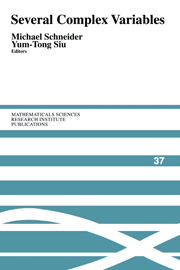Book contents
- Frontmatter
- Contents
- Preface
- Local Holomorphic Equivalence of Real Analytic Submanifolds in ℂN
- How to Use the Cycle Space in Complex Geometry
- Resolution of Singularities
- Global Regularity of the ∂-Neumann Problem: A Survey of the L2-Sobolev Theory
- Recent Developments in the Classification Theory of Compact Kahler Manifolds
- Remarks on Global Irregularity in the ∂-Neumann Problem
- Subelliptic Estimates and Finite Type
- Pseudoconvex-Concave Duality and Regularization of Currents
- Complex Dynamics in Higher Dimension
- Attractors in ℙ2
- Analytic Hilbert Quotients
- Varieties of Minimal Rational Tangents on Uniruled Projective Manifolds
- Recent Developments in Seiberg-Witten Theory and Complex Geometry
- Recent Techniques in Hyperbolicity Problems
- Rigidity Theorems in Kahler Geometry and Fundamental Groups of Varieties
- Nevanlinna Theory and Diophantine Approximation
How to Use the Cycle Space in Complex Geometry
Published online by Cambridge University Press: 25 June 2025
- Frontmatter
- Contents
- Preface
- Local Holomorphic Equivalence of Real Analytic Submanifolds in ℂN
- How to Use the Cycle Space in Complex Geometry
- Resolution of Singularities
- Global Regularity of the ∂-Neumann Problem: A Survey of the L2-Sobolev Theory
- Recent Developments in the Classification Theory of Compact Kahler Manifolds
- Remarks on Global Irregularity in the ∂-Neumann Problem
- Subelliptic Estimates and Finite Type
- Pseudoconvex-Concave Duality and Regularization of Currents
- Complex Dynamics in Higher Dimension
- Attractors in ℙ2
- Analytic Hilbert Quotients
- Varieties of Minimal Rational Tangents on Uniruled Projective Manifolds
- Recent Developments in Seiberg-Witten Theory and Complex Geometry
- Recent Techniques in Hyperbolicity Problems
- Rigidity Theorems in Kahler Geometry and Fundamental Groups of Varieties
- Nevanlinna Theory and Diophantine Approximation
Summary
In complex geometry, the use of n-convexity and the use of ampleness of the normal bundle of a d -codimensional submanifold are quite difficult for n > 0 and d > 1. The aim of this paper is to explain how some constructions on the cycle space (the Chow variety in the quasiprojective setting) allows one to pass from the n-convexity of Z to the O-convexity of Cn(Z) and from a (n + l)-codimensional submanifold of Z having an ample normal bundle to a Cartier divisor of Cn(Z) having the same property. We illustrate the use of these tools with some applications.
1. Basic Definitions
Let Z be a complex manifold; recall that an n-cycle in Z is a locally finite Sum
Topology of the cycle space. For simplicity we assume here that cycles are compact. The continuity of a family of cycles (Cs)s ∈ s consists of two conditions: - Geometric continuity of the supports: This is the fact that ﹛s ∈ 5/|Cs| ⊂ U﹜ is open in S when U is an open set in Z. - Continuity of the volume: For any choice of a continuous positive hermitian (1,1) form on Z, the volume function
For more information on the relationship between volume and intersection multiplicities, see [Barlet 1980c]. A main tool in the topological study of cycles is E. Bishop's compactness theorem (see [Bishop 1964; Barlet 1978a; Lieberman 1978; Fujiki 1978; SGAN 1982]): THEOREM 1. Let Z a complex analytic space and Cn(Z) the (topological) space of compact n-cycles of Z.
Information
- Type
- Chapter
- Information
- Several Complex Variables , pp. 25 - 42Publisher: Cambridge University PressPrint publication year: 2000
